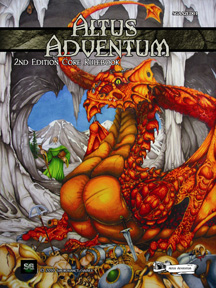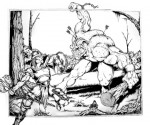Altus Adventum
Altus Adventum is a complete role-playing game powered by a unique system and published by Sacrosanct Games.
By Roderic Waibel

Welcome to the twelfth Designer’s Diary, a regular column where designers are given the opportunity to take readers on an in-depth ride through the design and development process of their system, setting, or product.
Designer’s Description
Altus Adventum is your typical high fantasy tabletop RPG with a lot of the traditional literary references and myth that you find in the genre today. It is a skill-based game that utilizes a dice pool mechanic that is not what you would find in most other RPGs that utilize dice pools. In fact, the mechanic is much more similar to RISK than other more common systems (counting successes, tally’s, etc) Specifics and details will be answered in greater detail below.
Purpose
Like most game designers, the initial purpose of creating Altus Adventum was because there wasn’t a system out there that really fit my gaming group’s needs. As the gaming industry was growing in the 1980s and what I call “rulebook bloat” was taking place, we wanted a gaming system that captured the atmosphere we preferred, but with a system that moved very quickly. What I mean by “rulebook bloat” is that by the time the late 80s came around, there were dozens of rulebooks out there for the same game. This really took off in the 1990s with the addition of splat books. This made it really hard for the Game Masters (GMs) because your players could have expansions, books, etc, that you might not have read. It just became too much. I am of the philosophy that you shouldn’t have to have a dump truck to bring your gaming aids to a session because there are so many of them.
That was one of the reasons. The other was from my experiences at the gaming table. I’m sure we’ve all been there when during a combat encounter, you may be waiting 5, 10, or even 30 or more minutes before your turn. How many of us have seen players build dice towers out of boredom? I’m willing to bet all of us at some point. So that was another reason for designing Altus Adventum. I wanted a combat system that kept a lot of the flexibility but moved a lot more quickly during those encounters.
And the third reason? As our games became more advanced and the rulebook bloat I talked about became more prevalent, we saw a rise in the number of rules lawyers out there. That isn’t to say we didn’t have rules lawyers in the late 70s or early 80s, but I think the Gygaxian prose of that era was such that for most gamers, we just made the rules up on the fly or ignored the ones we didn’t like rather than try to interpret Gary. With the rise of rulebook bloat, and having a lot more people do the writing that was easier to follow, I noticed a lot more rules lawyers come about. Of course, this is all anecdotal, so I want to caution that my observations don’t necessarily mean it was objective truth for most gamers. So I make it very clear in Altus that every rule is optional. I state right up front that if there is a rule you want to change, want to ignore, or want to follow, go for it. The goal is to have fun, not bicker over a rules interpretation.
Influences
My biggest influences were those folks from the late 70s and early 80s: Gygax, Arneson, Moldvay, Mentzer, etc. I.e., pretty much everyone who was involved in early D&D. Call it nostalgia, but that was my favorite era of gaming, and my favorite editions of D&D to this day. That’s something I definitely wanted to capture with Altus. Not the mechanics or rules per se, but the atmosphere and feel.
Research
Most of my research was around the monsters. What I wanted to do was bring the monster descriptions back to the way they were in original myth and folklore.

Art Direction
This was a big one for me since my goal was to emulate the atmosphere of early gaming. I wanted to focus on an art style that was reminiscent of the 70s and 80s. It doesn’t have to be the most technically accurate work, but it had to help portray the feel of the artists of that era. It’s all about atmosphere. In that vein, I lucked out and Larry Elmore was kind enough to grant me rights to use some of his full page illustrations for the 2nd edition rulebook. Additionally, you may or may not recall that in the AD&D Dungeon Master’s Guide, there is a scrolling continuous set of art that depicts a party of adventurers dungeon crawling. As a bit of an homage, I have something very similar to that as well in Altus.
Gaming Experience
Old school kill them and take their stuff. That really sums it up.

Comparison
Altus is similar to most high fantasy RPGs insofar as the theme goes. Humans, elves, dwarves, etc. But where it is different is in the mechanics. As I mentioned, it is a skill based system. That’s hardly unique, but what it allows is for players to completely mold their characters how they want, and it’s never too late to move in a different archetype. I’m sure we’ve all been there when you made up your character (based on party need perhaps?) and after a few adventures or so, you wished you went a different route. But it’s too late now, without having to start a new character. Altus addresses that by not having any traditional “classes” so-to-speak. As you gain experience, you use that to purchase new skills. There’s nothing stopping a character who was built for melee combat to switch and start learning magic.
But what really sets Altus apart from other RPGs are the combat mechanics. As I mentioned above, it is somewhat similar to RISK. And as I also mentioned, I wanted to include players in the act of combat even if they weren’t performing an action themselves. What this means is that players are actively engaged when they are being attacked, rather than just waiting to see how many hp their character suffers. Essentially all participants have an attacking dice pool, and a defending dice pool. These pools are determined by factors such as player skill, magic item bonuses, and attribute bonuses. The pool level tells the player how many and what type of dice are in his or her pool. For example, if you have a dice pool level of 6, you might have 1d8 and 2d6 in your pool. Because modifiers that impact your dice pool level are typically handled outside of combat, the pool level rarely is affected in the heat of battle so you don’t need to keep referencing which dice you roll every time you attack and defend—the dice stay pretty much the same.
So how is this like RISK? Well, each attacker has his or her dice pool, and each defender has his or her dice pool. Both parties roll their dice pool and compare the highest number showing. Whoever has the highest number wins. There are additional rules for ties, etc, but that’s the gist of it. Based on this system, there is no adding, subtracting, or whatever during combat itself. You don’t roll a d20 and then take a few seconds adding all of your modifiers to see if you hit for example. It makes everyone’s turn go by much faster that way.
Development Process
The initial game concept was done in 1986 with a group of 4 friends of mine. Originally it was a game designed to be generic of all genres: post-apocalyptic, fantasy, wild west, sci-fi, etc. However, in the early 2000s it was determined that to really get what I wanted from a gameplay perspective, I’d need to separate them out. Fantasy is mostly melee & magic, while most everything else was mostly about firearms. Two completely different ways players resolve combat if you will. Therefore I felt that in order to really give each genre it’s due process, I’d need to separate them. Altus was the first to be completed because as a high fantasy game, it was easiest to do. Bleeding Sky (a game that focuses on more modern combat) is still in progress.
Additionally, as mentioned above one of my goals was to emulate early 80s gaming. With Bleeding Sky, it worked best to take a more modern approach to art direction and layout, whereas with Altus, I wanted to go the more old school route. In fact, in order to help achieve this, I made a focus to pay attention to the little things as well, such as font styles, map styles, layout styles, etc. The font used for Altus is TW Cent, which is almost exactly like that in the early AD&D books. And the font for most of the adventures is Souvenir, which is what was used in the Moldvay B/X games. I think these little things help achieve the goal I was going after.
The 2nd edition of Altus was actually finalized last year. The first edition came out in 2002 as a rules-lite free RPG, but it was clear that a refined, expanded ruleset would be needed. Not only for game balance issues, but to really expand the game.


